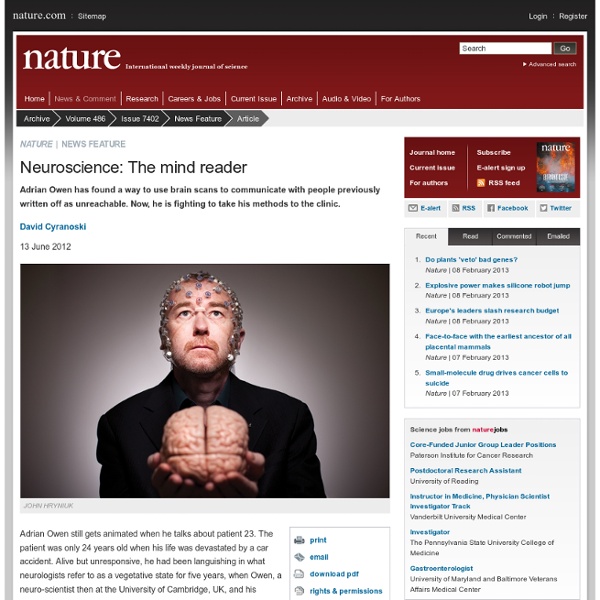Neuroscience: The mind reader

Somewhere over the brainbow: New 3D maps of the brain will
Magnetic resonance scanner builds first 3D interior maps of brainCould allow treatment of brain disordersScans up until now 'have not shown the real brain,' say researchers By Rob Waugh Published: 10:43 GMT, 4 June 2012 | Updated: 16:00 GMT, 5 June 2012 Harvard scientists have developed hi-tech new methods to explore inside the human brain using magnetic resonance scanning. Professor Jan Wedeen claims that the rainbow-coloured scans offer the first real insight into the pathways of the human brain's 100 billion cells - and how it works. ‘The brain we’ve been looking at with conventional scans all these years is not the real brain,' says Wedeeen. A fluorescent 'brainbow' map of the connecting nerve cells in a brain by Harvard's Jeff Lichtman, which shows patterns of fibres interconnecting to form a 3D brain The 3D maps will allow us to see 'inside' the workings of the brain for the first time, claim the scientists 'But we don’t have real tools to understand it it.
只有半個大腦也能活? 人類大腦十項驚人事實報你知| 花生網
大陸新聞中心/綜合報導 大陸新聞中心/綜合報導 新浪科技據國外媒體報導,大腦是人體最重要的器官,同時也是最為複雜的器官。 1.大腦感覺不到疼痛 大腦內沒有疼痛感受器,這也就是為什麼外科醫生能夠在患者仍保持清醒的時候進行腦外科手術。 2.腦血管總長度達到16公里 人類的大腦由1000億個神經細胞構成,相當於銀河系內的恆星數量,總重量與一個羅馬甜瓜差不多。 3.愛因斯坦大腦被保留下來 1955年,愛因斯坦去世,但他的大腦卻被保留下來。 4.左右腦存在差異 大腦由左右腦構成,彼此對稱。 5.男性大腦比女性大10% 男性的大腦比女性大10%。 6.大腦在人睡覺時更活躍 進入夢鄉時,大腦會處理白天經歷的所有事情,一些科學家認為這是我們會做夢的原因所在。 7.控制夢境並非不可能 在所謂的『清醒夢』中,人們能夠控制夢境的結果。 8.人為什麼笑至今原因不明 笑是一種自然而然的行為,只有人類天生具有這種能力。 9.大腦大小很重要嗎? 大腦大小很重要嗎? 10.IQ最高紀錄210 韓國人金恩榮(Kim Ung-yong)是世界上IQ最高的人,高達210。 關鍵字:其他大陸生活花生網大腦人類血管器官疼痛IQ愛因斯坦 最新
阿凡達情節真實上演? 俄富豪砸重金創「腦控機器人」 | 新奇新聞
國際中心/綜合報導 電影《阿凡達》中,人類用意念就能控制新人類思想,而此種情節10年內可能真實上演。俄羅斯媒體大亨伊斯科夫(Dmitry Itskov)砸重金和30名科學家合作,計劃打造以人腦就能操控的機器人,且估2020至2025年間就能實現。 伊斯科夫準備進行這項名為「阿凡達計劃」的機器人工程,計劃將分成4個階段,分別是:人腦控制電腦、人腦移植電腦、人腦思想複製,最後打造出「永生人」。 所謂「永生人」是指將人類死後的大腦轉移到機器人身上後,讓人的生命能在機器人身上繼續存活,伊斯科夫宣稱,此項研究能讓人從疾病、老化及死亡中解脫,達到傳說中的「長生不老」。 關鍵字:俄國腦納美人國際阿凡達新奇富豪科普機器人 最新
Related:
Related:




" “In the end if they say they have no reason to believe the patient is conscious, I say 'fine, but I have no reason to believe you are either',” he says." by grok2 Jun 15